First female RAF pilot recalls trailblazing flight
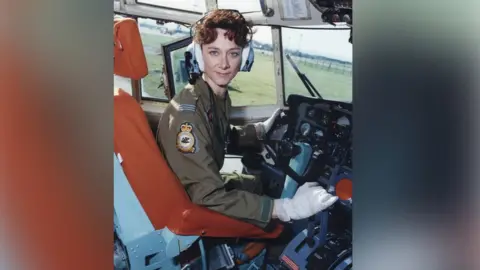 Crown Copyright
Crown CopyrightIt is 30 years since the Royal Air Force marked a watershed moment with the graduation of its first ever female pilot. Three decades later, the woman at the centre of that trailblazing moment remembers when she got her wings and set a course for others to follow.
When Flight Lieutenant Julie Ann Gibson's plane touched down at RAF Finningley, near Doncaster, South Yorkshire, on 14 July 1991 she entered the history books. For the first time in 73 years, the air force had a female pilot.
Women had played an integral role in the RAF since its inception in 1918, though the opportunities within it had remained limited to ground roles despite female pilots working in the commercial and civilian sectors.
All that changed, however, in 1989 when a ban on female pilots was lifted and a recruitment drive was launched.
For Julie, the opportunity was too good to miss and she sent her request on the day applications opened.
"I'd always wanted to be a pilot since I was in my teens," she said, "but there just weren't that many opportunities".
"I had always hoped it might change and I was very lucky - [it was] a dream come true."
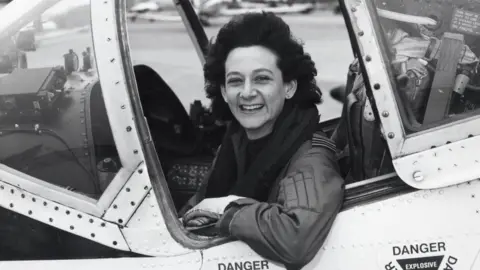 Crown Copyright
Crown CopyrightJulie was born into a military family. Both parents had been in the Royal Navy; her mother as a Morse code operator while her father was a submarine captain.
But her eyes had always been set on the heavens rather than the depths of the ocean and, before joining the RAF, she had trained as a private pilot.
Despite knowing she was destined to stay on terra firma she completed a degree in aeronautical engineering and joined the air force as an engineering officer in 1984.
Five years later, when applications were opened up to women, she was first in line.
After winning a place on the training course she was "well accepted and well-treated" by her male colleagues, she said.
"There weren't many female engineers in those days so the environment was nothing new in that way.
"Just because the numbers were mainly male didn't mean it was a hostile environment."
After completing her basic training at RAF Linton-on-Ouse, in North Yorkshire, she moved south to No 6 Flying Training School, which was then based near Doncaster.
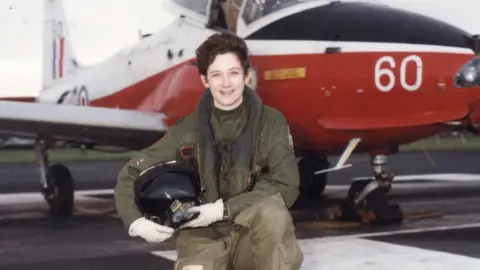 Julie Ann Gibson
Julie Ann GibsonYorkshire was already a home from home for Julie with her mother's family coming from the area, and during her training she became re-acquainted with it.
"They were very interesting times of my life, [it was] lovely to have some spare time in Yorkshire," she said.
"We often went for a lovely afternoon tea in York and there were lots of beautiful places to walk.
"The views when you're flying are very beautiful in that part of the world."
Now 59 years old and speaking from her home near Swindon, she said receiving her RAF Flying Badge - also known as 'wings' - was "the most amazing day".
"I was incredibly proud and excited having a career flying in the air force," she said.
"But the wings were only the start of it because I had been in training up until that point," she said.
And, while there were other women in training at the time, she said she was aware of the significance of her own breakthrough.
"The day that I got my wings was just the very beginning of opportunities for women being able to succeed in areas where men had always had the opportunity to," she said.
"There were other women who closely followed getting their wings.
"I think what we all hoped was that it would become the norm so that women could be selected for all jobs in the RAF without too much being said. That was the hope."
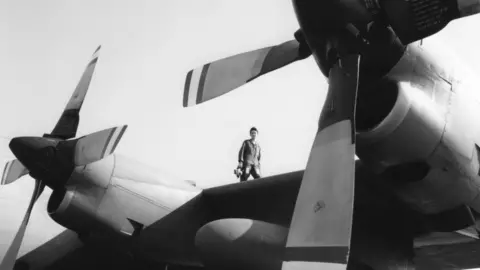 Julie Ann Gibson
Julie Ann GibsonOver the following 10 years Julie specialised in flying large, multi-engine aircraft.
She went on to captain Lockheed Hercules aircraft, based at RAF Lyneham in Wiltshire, and was tasked with transporting personnel and equipment all over the world.
The RAF have described her as a "a trailblazer of her time", but Julie remembers that not everybody approved of a woman being in charge of an aircraft.
On one occasion she recalls meeting a man in her civvies knowing she would be flying him home the following day.
However, unaware of who she was, he openly told her he "wouldn't want to fly with a female pilot".
"So, the next day, in my pilot's uniform, I think he said he wouldn't fly," she said.
"I said he had five minutes to get off the aircraft. He didn't, he just looked very sheepish and stayed on board."
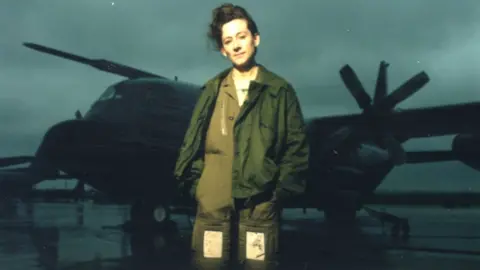 Julie Ann Gibson
Julie Ann GibsonWhatever others may have thought, Julie was a pioneer in the RAF, her graduation marking the start of a rapid progression for female pilots.
The following year, in January 1992, Flt Lt Sally Cox became the first female pilot selected for fast jet training.
Two years later in 1994, Flight Lieutenant Joanna Salter became the RAF's first female combat jet pilot.
And, in 2017, the RAF became the first branch of the British military to open up every role to men and women.
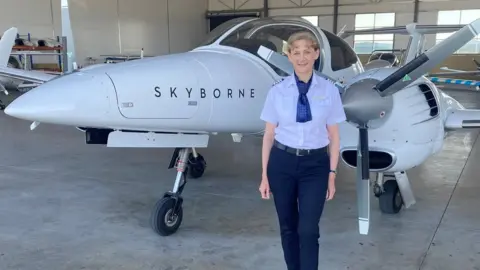 Skyborne Airline Academy
Skyborne Airline AcademyJulie retired in 2001, bringing to a close a 17-year career, and now works for an airline training school based near Cheltenham, helping to teach the next generation of pilots.
However, she remembers her time in the RAF with pride.
"Wearing those wings [was] a momentous achievement and the satisfaction stayed throughout my whole time in the air force," she said.
"Even now having been retired a long time I'm still very proud to have worn the RAF flying badge."

Follow BBC Yorkshire on Facebook, Twitter and Instagram. Send your story ideas to [email protected].
